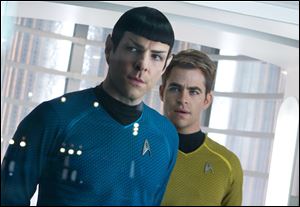
MOVIE REVIEW
Darkness and Light in new 'Star Trek' film
With 'Into Darkness,' J.J. Abrams goes where no ‘Star Trek’ movie has gone before
5/16/2013
Zachary Quinto, left, as Spock and Chris Pine as Kirk star in the movie, 'Star Trek Into Darkness.'
J.J. Abrams’ Star Trek was about restoring a moribund franchise. His sequel is about taking it for a spin.
Star Trek Into Darkness is an exhilarating ride, an action-packed film that completes the transformation of Gene Roddenberry’s science-fiction TV show about big-picture questions into a made-for-cinema space fantasy spectacle.
But even as Abrams asserts a new era for Star Trek, the axiom of its sequels remains consistent, that the even-numbered films are significantly better than the odd-numbered films mostly thanks to a strong villain.
Abrams and Star Trek screenwriters Roberto Orci and Alex Kurtzman, now with an assist by Damon Lindelof, provide Into Darkness with the kind of memorable antagonist that even their initial and successful foray into the Star Trek universe lacked. Their villain is a wayward Star Fleet super-soldier with his own agenda named John Harrison, played to chilling and fun effect by Benedict Cumberbatch. (As for his rumored identity, consider it one of the many surprises the film has in store. But if you just have to know, check out IMDB.com for the answer.) And like any good baddie, Harrison’s presence exists even when he’s not onscreen, though he’s never allowed to dominate the film.
RELATED ARTICLE: 'Star Trek,' sans Shatner, all about ensemble
Into Darkness doesn’t even open with an introduction to Harrison, rather it’s Captain Kirk (Chris Pine) and Dr. “Bones” McCoy (Karl Urban) fleeing from an angry and primitive alien tribe in a failed undercover visit to their planet, while Mr. Spock (Zachary Quinto) attempts to prevent a massive volcanic eruption that will wipe out their civilization. The sequence has the importance of introducing core themes of the film, but it also has the deliberate feel of the frantic last 15 minutes of a Star Trek TV episode, albeit one with the considerable additions of a huge budget and a major Hollywood name at the helm.
Star Trek Into Darkness: ★★★★½
Director:J.J. Abrams.
Written by: Roberto Orci, Alex Kurtzman, and Damon Lindelof.
Studio: Paramount release
Playing: Rave Franklin Park, Fallen Timbers, and Levis Commons.
Rating: PG-13 for intense sequences of sci-fi action and violence.
Running time: 132 minutes.
Starring:
- Kirk: Chris Pine
- Khan: Benedict Cumberbatch
- Spock: Zachary Quinto
- Dr. McCoy: Karl Urban
- Uhura: Zoe Saldana
After this misadventure Harrison shows up, at first offering aid to a father in distress in London while later using that goodwill to strike back at others. He proves to be even more dangerous and cunning after a surprise attack on Star Fleet headquarters, so Kirk and crew are dispatched to find and kill the genetically modified terrorist, who’s now hiding on a remote planet inside Klingon territory. Kirk captures the criminal and opts to spare his life so that he may instead face a trial, only to learn that his decision may be part of Harrison’s larger plan, and that who he thought was the enemy may be his key to survival. Or not.
There’s no shortage of ship-to-ship space battles, hand-to-hand combat, and mega crashes and disasters, as Abrams brings an even larger scale to Into Darkness than he did with Star Trek. The visual effects are spectacular and he makes clever use of the 3-D. More importantly, his pacing is popcorn-movie perfect, pushing the film forward with action and thrills, but pulling back the adrenalin for the important character moments.
Among the smaller character arcs: Captain Kirk wrestling with whether he’s fit to command a starship; Mr. Spock and Uhura (Zoe Saldana) struggling in their romantic relationship; Scotty (Simon Pegg) relieved of his engineering duties, and Sulu (John Cho) and Chekov (Anton Yelchin) finding themselves in unfamiliar roles on the Enterprise. As for McCoy ... he’s mainly comic relief. If there is a complaint to be made about Into Darkness it’s that the familiar tics and expressions of each Star Trek character are frequent go-to devices for the script when it wants to lighten the mood. Urban’s homage to DeForest Kelley’s McCoy, for instance, as funny as it often is, comes perilously close to parody.
Yet there’s a palpable new comfort level among the performers in their iconic roles for the second time and working from a script that has moved beyond introductions and reacquaintances for audiences. Captain Kirk is no longer simply a work-in-progress reboot, but the familiar brash ladies’ man made increasingly distinct by vulnerabilities and insecurities. Pine’s performance is less about hero Captain Kirk as it is human Captain Kirk.
Quinto brings warmth to the coldly logical Spock, as the Vulcan continues his struggles with his half-humanity and the emotions that come with it, including dealing with the strong and strongly opinionated Uhura. Her character enjoys the biggest boost in screen time and importance over any previous Star Trek movies, as the Enterprise’s communications officer proves herself to be quite handy with alien languages and phasers, as well as putting Spock in his place.
While the film may borrow heavily from previous even-numbered Star Trek films (the twisty plot of Star Trek VI: The Undiscovered Country, the relentless action and pace of Star Trek II: The Wrath of Khan, and the friendly humor of Star Trek IV: The Voyage Home), it also establishes its own identity. This is as big and bold as any Star Trek yet.
While Abrams departs the series — perhaps for good — to direct the next Star Wars installment for 2015, he leaves Star Trek in much better shape — healthy, vibrant, and made for the mainstream — than when he took over.
Contact Kirk Baird at kbaird@theblade.com or 419-724-6734.